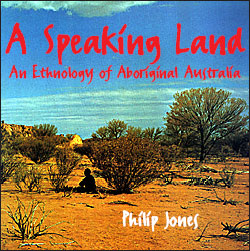A Speaking Land An Ethnology of Aboriginal Australia
A Speaking Land analyses the technological and aesthetic achievements of Australia’s
Aboriginal societies, as known at the period of first contact. The central thesis of the book is that
Aboriginal people fashioned a civilisation founded upon elegant solutions to an enduring problem – how
to live and prosper in one of the harshest of the world’s environments, in which options for agriculture
and the domestication of native animals did not (and could not) emerge.
Given the prevailing stereotype of traditional Aboriginal culture as spiritually rich but materially
impoverished, this book has an ambitious brief, but one founded upon a distillation, in plain language,
of a wealth of complex data, linked to tangible objects and their stories, and localised to their Aboriginal
contexts. The text moves from continent-wide generalisation set within an international frame, to
fine-grained anecdotes that show how, for example, fire-making, bird-trapping techniques or shield design
varied from region to region. The tangible evidence for these Aboriginal solutions now rests in museum
collections - and this book will be based on the world’s most outstanding and comprehensive collection
of Aboriginal material culture, held by the South Australian Museum.
The book is organised around a double, interweaved structure of ‘themes and technologies’. Each
informs the other: the various technologies enabled Aboriginal society to function socially and aesthetically,
and to successfully sustain itself. Conversely, a society functioning with its norms and social rules intact
enabled those technologies to be applied to best effect. It is thus possible to conceive of most Aboriginal
material culture as vital evidence for the successful solution of a series of related problems: how to create
efficient weapons, locate and conserve supplies of water, undertake the daily food quest, provide shelter
and warmth, create and preserve meaningful social links between individuals and groups, and express ideas
of beauty, symmetry and order. These challenges must be met for a culture to flourish.
Each solution, arrived at during the millennia of Aboriginal occupation of this country, finds material
expression in an artefact or a technique. Through their variation across the continent, these artefacts
suggest a breadth and depth of adaptation that confounds most stereotypes of Aboriginal culture
as primitive and shallow. The deft knotting of a Diamantina fishing net, the dappled patterning of a
Queensland rainforest shield, the jagged stingray barbs of a Cape York spear, the tight weave of an Arnhem
Land honey basket, or the interlocking key design of a Kimberley shield - all are cultural gestures that reflect
the successful engagement of their makers’ knowledge with the local environment.
The reader will be shown that Aboriginal technology should be regarded against the canvas of social
action, or conversely, that the quest for food and water was not simply a technological problem, but may
also be regarded in social terms. In other words, the material elements of the culture have a place in a
coherent system, and are not merely disconnected artefacts.
A Speaking Land places Aboriginal material culture in a vivid social and historical context, offering a
fresh explanation of the viability and strengths of traditional ways of life. While such a discussion can
never be definitive, this book will become known as a basic text on traditional Aboriginal culture and
society, written from the perspective of the material evidence.
|
|

AUTHOR:
Philip Jones
STATUS:
Forthcoming
PRICE:
$79.95
ILLUSTRATIONS:
Numerous colour and black-andwhite
photographs, maps and
diagrams
FORMAT:
Hardcover; c. 300 pages
DIMENSIONS:
285 x 285 mm
ISBN:
1863332286
|
|

